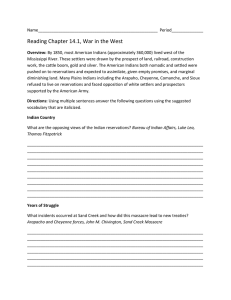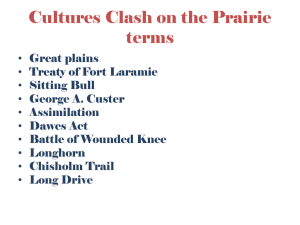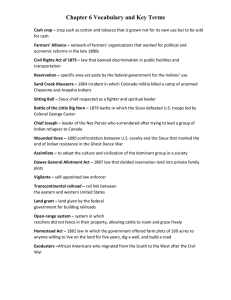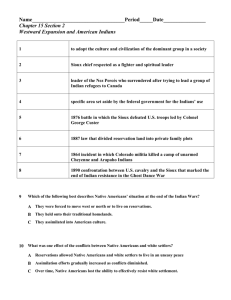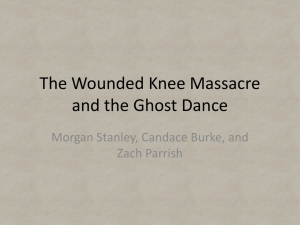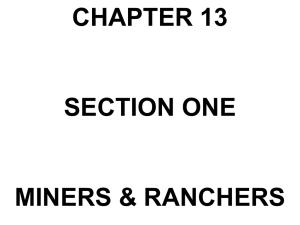Chapter 5 - CasandraDutzer
advertisement
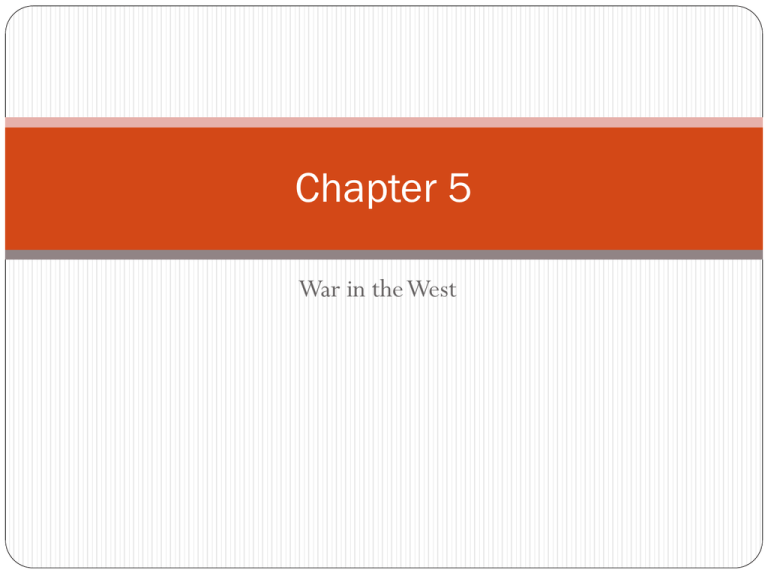
Chapter 5 War in the West Indian Country By 1850, 360,000 American Indians lived west of the Mississippi River 1851 Treaty of Fort Laramie had guaranteed American Indians land rights on the Great Plains However, as white settlers moved west, the US government tried to get more land Bureau of Indian Affairs Government agency responsible for managing American Indian issues Reservation system Today’s BIA Bureau of Indian Affairs Sand Creek Massacre Cheyenne and Arapaho tribes refused to live on reservations In Colorado Territory these tribes clashed with the local militia through the summer of 1864 Cheyenne chief, Black Kettle, went to the militia to make peace While most Cheyenne men were away hunting, John M. Chivington and 700 men came and opened fired on the Cheyenne camp Over 200 Cheyenne died, mostly women and children American Indians responded with attacks Sand Creek Massacure, Colorado The Battle of Little Bighorn Sitting Bull emerged as a leader of the Sioux He was committed to traditional ways of life He was completely against moving to reservations and urged other American Indians to stay away from reservations By 1876, he got thousands of Sioux and Cheyenne allies together (2,500) June 25, 1876 George Armstrong Custer and 600 members of the U.S. Army attacked Sitting Bull’s men and his Cheyenne allies This would be the last victory for the Sioux and their allies The Battle of Little Bighorn The Ghost Dance Many American Indians began a religious movement called the Ghost Dance A dance ritual designed to bring Indian ancestors back to life BIA agents dismissed this Ghost Dance and felt it would inspire rebellion Dec. 15, 1890 skirmishs broke out around Sitting Bull’s cabin and 14 Indians and Sitting Bull were killed The Battle at Wounded Knee After Sitting Bull’s death, many American Indians banded together Another Sioux leader, Big Foot, feared he would be arrested by the US government Therefore, he led a group west to the Pine Ridge Reservation in SD and made camp along Wounded Knee Creek Dec. 28, 1890, army troops found Big Foot The next day, Colonel James Forsyth ordered the seizure of the Sioux rifles Tensions ran high and shots were fired By the end of the day, 150 Sioux and about 30 U.S. soldiers were dead This was the end of the bloody conflict between soldiers and Am.In. Hotchkiss gun U.S. army member used this gun to open fire during the Battle of Wounded Knee Assimilating American Indians “white America” U.S government set up schools Forced to speak English, wear “proper” clothes, and change their names Dawes General Allotment Act-Am. In. families were given 160 acres of reservation land for farming Trail of Tears Trail of Tears
